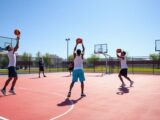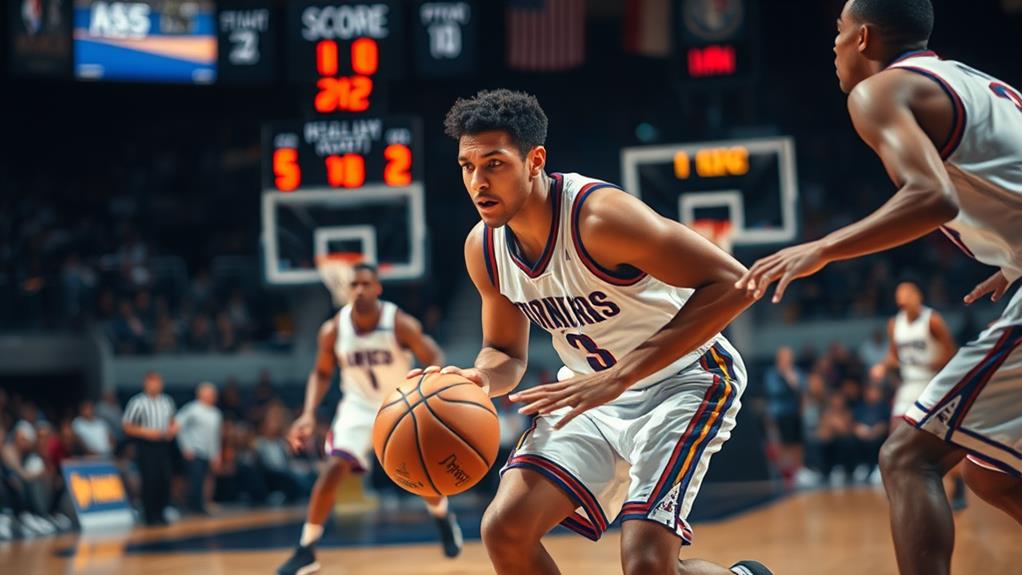
What Is a Turnover in Basketball and How to Minimize Them
October 3, 2024A turnover in basketball happens when you lose possession to the opposing team due to mistakes like bad passes or traveling violations. These errors disrupt your team's offense and give the other side a chance to score. To minimize turnovers, focus on improving your ball-handling skills and decision-making. Practice crisp passing and proper footwork to avoid violations. Establish clear communication with your teammates to reduce misinterpretations during plays. Aim for a turnover count of 12-15 per game to boost your chances of winning. Stick around to uncover more strategies that can help elevate your game even further.
Understanding Turnovers
Understanding turnovers is essential for any basketball player or coach aiming for success on the court. A turnover occurs when you lose possession to the opposing team, often due to errors like bad passes, poor ball handling, or even offensive fouls. These mistakes disrupt your team's offensive flow and can lead to scoring opportunities for your opponent, making it critical to minimize them.
By utilizing analytics to optimize player positions and enhance decision-making, players can considerably improve their performance and reduce turnover rates. To reduce turnovers, players must focus on making smart decisions during the game. This includes improving ball handling skills and executing accurate passing. Being aware of your surroundings and anticipating the movement of teammates can greatly decrease the likelihood of a turnover.
Additionally, poor footwork can contribute to unnecessary mistakes, so working on your footwork fundamentals is essential.
Statistically, teams that average between 12 to 15 turnovers per game have a better chance of winning, while exceeding 30 turnovers can drastically lower your win percentage. Every turnover can cost your team approximately 1.5 points, highlighting the impact they've on game outcomes.
Common Causes of Turnovers
When you're on the court, errant passes can quickly turn into costly turnovers, often due to miscommunication with your teammates.
This lack of communication can be exacerbated by the diverse backgrounds of players, as increased diversity in athletic representation can lead to different playing styles.
Traveling violations also happen when you lose track of your footwork, which can disrupt your rhythm.
Plus, defensive pressure can force you into hasty decisions, making it essential to stay composed under stress.
Errant Passes
Errant passes are a leading cause of turnovers in basketball, often derailing offensive plays and handing the defense easy scoring opportunities. As an offensive player, you need to recognize that poor timing and miscommunication can lead to these mistakes.
When you attempt complex or risky passes instead of simpler options, the chances of errant passes increase considerably. To minimize miscommunication, focus on making accurate, on-target passes that reach your teammates on their shooting side.
Practicing passing drills that simulate game situations can sharpen your decision-making skills and enhance your accuracy. These drills help you maintain control of the ball and guarantee your passes connect with precision.
Additionally, analyzing game film can be invaluable. By reviewing specific instances of errant passes, you can identify patterns and areas for improvement.
This reflection allows you and your team to address mistakes in practice, ultimately reducing the frequency of turnovers. Remember, mastering the art of passing is essential to keeping the game flowing and maximizing scoring opportunities for your team.
Traveling Violations
Turnovers can stem from various mistakes on the court, with traveling violations being a notable contributor. These violations occur when you take too many steps without dribbling, often leading to a turnover. One common cause is failing to establish a pivot foot. If you lift your pivot foot before passing or shooting, you risk being called for traveling.
Poor footwork, especially during fast breaks or quick direction changes, can also lead to these violations. To minimize traveling violations, focus on maintaining proper awareness of your foot placement. Practicing jump stops can greatly reduce the likelihood of these errors, allowing you to remain in control while handling the ball.
Coaches recommend regular drills that emphasize footwork techniques, such as pivoting and step-throughs. By internalizing correct movements, you can avoid basketball mistakes that lead to turnovers.
Defensive Pressure
How do you handle the pressure when defenders are closing in? Facing defensive pressure, like full-court presses, can lead to turnovers if you're not prepared. It forces you into hurried decisions, increasing the chance of mistakes.
Remember, opponents can capitalize on this, averaging 1.5 points per turnover, which can swing game momentum dramatically.
To minimize turnovers, quick decision-making is essential. Stay calm and visualize your options. Good spacing and communication with your teammates are vital in these high-pressure situations. This approach helps create better passing lanes and allows for more effective plays.
Incorporating situational drills into your practice routine can also prepare you for real-game scenarios. By simulating defensive pressure, you'll learn to make faster, smarter decisions under stress. These drills enable you and your teammates to develop a strong understanding of how to respond when defenders apply pressure.
Ultimately, staying composed, communicating clearly, and practicing under pressure will help you manage defensive tactics without falling into the turnover trap. Focus on these strategies, and you'll find yourself making better choices on the court.
Impact of Turnovers
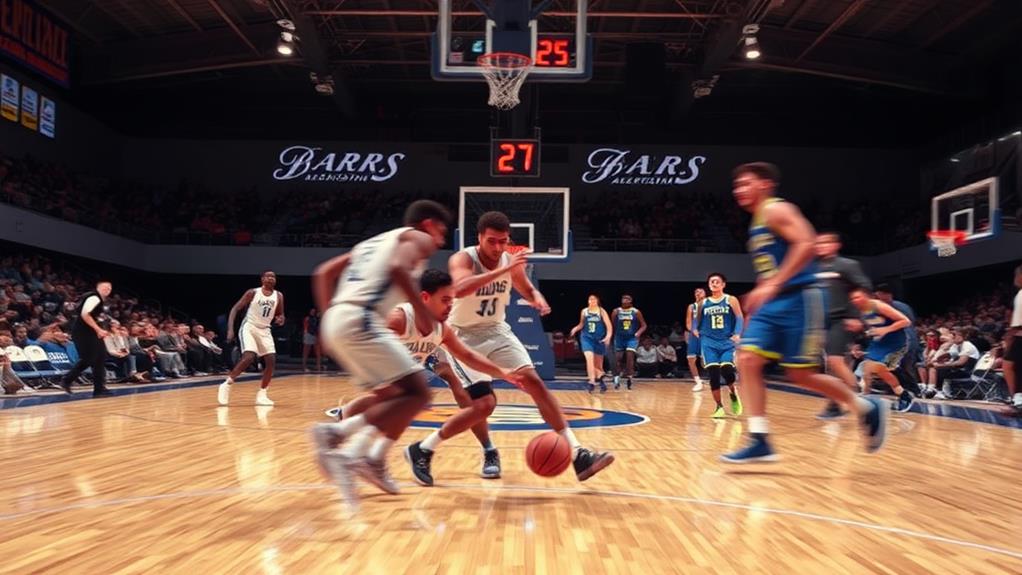
Basketball teams can't afford to underestimate the impact of turnovers on their performance. Each turnover not only results in losing possession but also directly leads to missed scoring opportunities for your team.
With each turnover potentially allowing the opposing team to score an average of 1.5 points, it's vital to pay attention to your turnover stats. In soccer, a similar focus on possession and minimizing errors can lead to greater success, as evidenced by soccer-related content that highlights teamwork and strategy.
Consider these key impacts of turnovers:
- High turnover rates correlate with decreased win percentages.
- Teams averaging over 15 turnovers per game often struggle with control and momentum.
- Excessive turnovers disrupt your offensive flow, increasing frustration.
- A lower turnover count can boost team morale and confidence.
- Maintaining a range of 12-15 turnovers per game enhances overall efficiency.
To succeed, you need to focus on minimizing turnovers. When you reduce turnovers, you not only improve your footwork but also help maintain your team's rhythm against pressure defenses.
Strategies to Reduce Turnovers
Reducing turnovers is essential for any successful basketball team, and implementing effective strategies can make a significant difference. To start, regularly tracking and analyzing turnover statistics helps you identify patterns and areas for improvement. Aim for a target of 12-15 turnovers per game to enhance your team's performance.
Incorporating advanced performance tracking technology can provide valuable insights into player habits and decision-making processes, allowing for targeted improvements in gameplay. innovations in offensive strategies can also play a vital role in minimizing turnovers by emphasizing efficient ball movement and spacing.
Focus on developing good footwork techniques, such as jump stops and establishing a pivot, which can help you avoid turnovers and reduce traveling violations. Incorporating dynamic passing drills that simulate game conditions will improve your passing accuracy and decision-making under pressure.
Encourage simple passing techniques; making crisp, accurate passes minimizes risky plays that could lead to turnovers. Utilizing video analysis to review game footage can also be beneficial. Highlight turnovers for discussion and collective learning, reinforcing awareness and encouraging strategic adjustments among players.
Fundamental Skills for Control
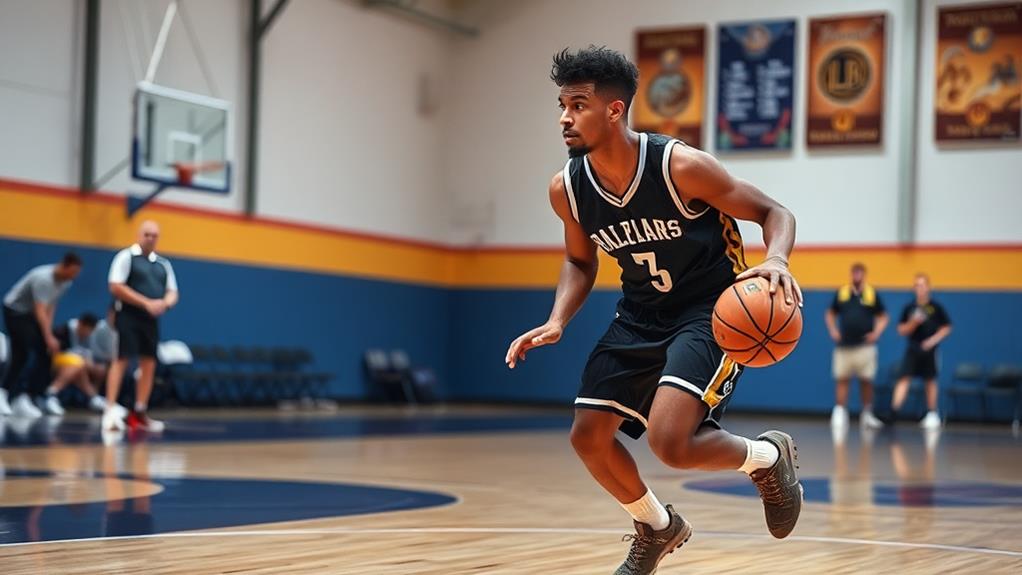
In any sport, mastering the fundamental skills is essential for maintaining control, and basketball is no exception. To minimize turnovers, you need to focus on honing specific skills that enhance your ability to handle the ball effectively.
With the evolution of defensive strategies in basketball, players must also adapt their skill set to counteract sophisticated defensive tactics, such as informed defensive schemes that utilize analytics. Here are key areas to concentrate on:
- Ball-handling techniques: Regularly practice dribbling drills to improve your control and reduce errant passes.
- Proper footwork: Work on jump stops and pivots to avoid traveling violations that often lead to turnovers.
- Simple, accurate passes: Emphasize making straightforward passes instead of complex ones, as this reduces the chances of mistakes.
- Catching skills: Engage in drills that enhance your two-handed catching ability, ensuring you maintain possession and control.
- Protecting the ball: Always be mindful of ball protection during gameplay, especially in shifts, to prevent risky dribbles that could result in turnovers.
Game Situations and Turnovers
During intense game situations, turnovers can become a notable hurdle that disrupts your team's momentum. Fast breaks often lead to these mistakes, especially when players fail to communicate effectively. Misguided passes can derail your offensive flow, resulting in lost scoring opportunities.
Additionally, when facing press defenses, the pressure can cause players to rush their decisions, increasing the likelihood of errant passes and violations. Effective communication among team members, similar to the way defenders communicate in soccer, is essential in minimizing these errors.
In half-court offense scenarios, maintaining patience is essential. Poor shot selection or forced plays can easily lead to turnovers, so players should learn to recognize when to take a shot and when to reset the play.
Understanding your opponent's defensive setups and maintaining proper spacing can notably reduce turnovers during the game.
Tracking specific types of turnovers in various situations helps identify patterns. By analyzing these patterns, you can inform targeted practice strategies that enhance player decision-making skills.
Ultimately, situational awareness and strategic movement are key to minimizing turnovers and improving your overall game performance. Focus on these elements, and you'll find your team can maintain momentum even in the most intense moments.
Enhancing Team Communication
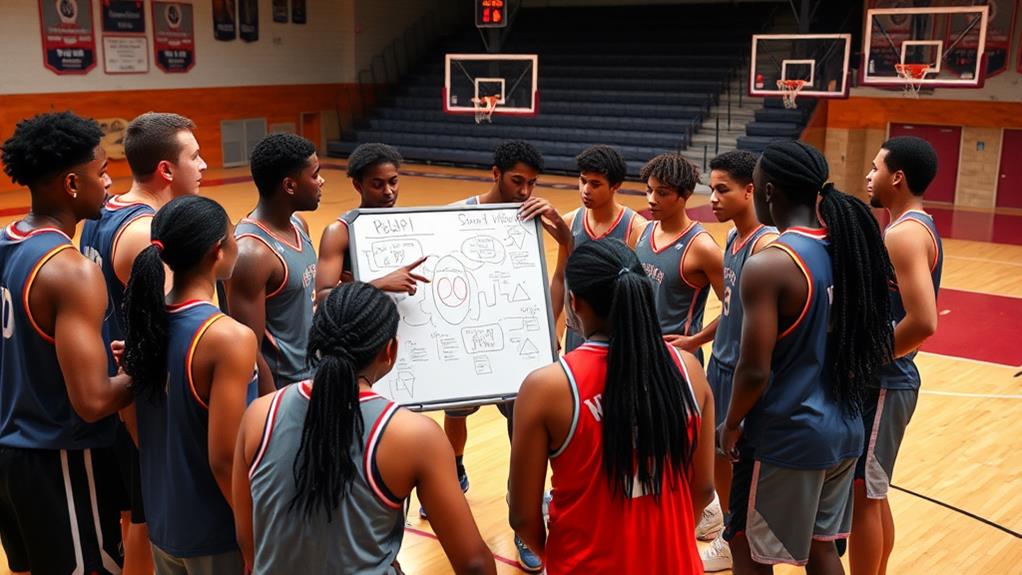
Turnovers often stem from miscommunication on the court, making it vital to enhance team communication. By focusing on effective communication, you can greatly reduce turnovers and improve your team's performance.
Modern basketball strategies, particularly the role of centers in facilitating ball movement, emphasize the importance of clear communication in executing plays. Here are some strategies to reflect upon:
- Establish a pivot: Make sure players know when and where to pass the ball, preventing unnecessary confusion.
- Use non-verbal signals: Hand gestures can help coordinate plays during high-pressure moments, minimizing errors that lead to turnovers.
- Hold regular team huddles: Discussing game strategies fosters a better understanding of each player's role, which is vital for smarter decision-making.
- Encourage vocal play: Calling out defensive assignments and screens boosts situational awareness, decreasing the chance of miscommunication.
- Incorporate practice drills: Scrimmages with specific communication requirements reinforce teamwork and enhance overall ball control.
Conclusion
To summarize, minimizing turnovers isn't just about skill; it's a team effort that can greatly impact your game. Did you know that teams with fewer than 10 turnovers per game win over 70% of their matches? By focusing on communication and fundamental skills, you can boost your performance and increase your chances of winning. So, keep practicing, stay aware of your surroundings, and work together to keep those turnovers down!

